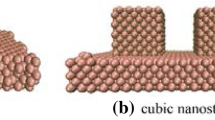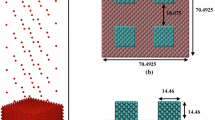Abstract
Molecular dynamic simulations are performed to study the effects of nanostructure on rapid boiling of water that is suddenly heated by a hot copper plate. The results show that the nanostructure has significant effects on energy transfer from solid copper plate to liquid water and phase change process from liquid water to vapor. The liquid water on the solid surface rapidly boil after contacting with an extremely hot copper plate and consequently a cluster of liquid water moves upward during phase change. The temperature of the water film when it separates from solid surface and its final temperature when the system is at equilibrium strongly depend on the size of the nanostructure. These temperatures increase with increasing size of nanostructure. Furthermore, a non-vaporized molecular layer is formed on the surface of the copper plate even continuous heat flux is passing into water domain through the plate.










Similar content being viewed by others
References
Gad-el-Hak M (1999) The fluid mechanics of microdevices—the Freeman scholar lecture. J Fluids Eng 121(1):5–33
You S, Simon TW, Bar-Cohen A (1992) A technique for enhancing boiling heat transfer with application to cooling of electronic equipment. IEEE Trans Compon Hybrids Manuf Technol 15(5):823–831
Lin C, Kim Y, Niedrach L, Ramp K (1996) Electrochemical corrosion potential models for boiling-water reactor applications. Corrosion 52(8):618–625
Kandlikar SG (2002) Fundamental issues related to flow boiling in minichannels and microchannels. Exp Therm Fluid Sci 26(2):389–407
Mao Y, Zhang Y (2014) Molecular dynamics simulation on rapid boiling of water on a hot copper plate. Appl Therm Eng 62(2):607–612
Faghri A, Zhang Y (2006) Transport phenomena in multiphase systems. Academic Press, Burlington
Xu X (2002) Phase explosion and its time lag in nanosecond laser ablation. Appl Surf Sci 197:61–66
Novak BR, Maginn EJ, McCready MJ (2008) An atomistic simulation study of the role of asperities and indentations on heterogeneous bubble nucleation. J Heat Transf 130(4):042411
Takamizawa A, Kajimoto S, Hobley J, Hatanaka K, Ohta K, Fukumura H (2003) Explosive boiling of water after pulsed IR laser heating. Phys Chem Chem Phys 5(5):888–895
Kudryashov SI, Allen SD (2006) Submicrosecond dynamics of water explosive boiling and lift-off from laser-heated silicon surfaces. J Appl Phys 100(10):104908
Seyf HR, Zhang Y (2013) (a). Effect of nanotextured array of conical features on explosive boiling over a flat substrate: a nonequilibrium molecular dynamics study. Int J Heat Mass Transf 66:613–624
Matsumoto SMTKS, Kimura YYT (1998) Liquid droplet in contact with a solid surface. Microscale Thermophys Eng 2(1):49–62
Yi P, Poulikakos D, Walther J, Yadigaroglu G (2002) Molecular dynamics simulation of vaporization of an ultra-thin liquid argon layer on a surface. Int J Heat Mass Transf 45(10):2087–2100
Maroo SC, Chung J (2008) Molecular dynamic simulation of platinum heater and associated nano-scale liquid argon film evaporation and colloidal adsorption characteristics. J Colloid Interface Sci 328(1):134–146
Seyf HR, Zhang Y (2013) Molecular dynamics simulation of normal and explosive boiling on nanostructured surface. J Heat Transf 135(12):121503
Maruyama S, Kimura T, Yamaguchi Y (1997) A molecular dynamics simulation of a bubble nucleation on solid surface. Natl Heat Transf Symp Jpn 34:675–676
Nagayama G, Tsuruta T, Cheng P (2006) Molecular dynamics simulation on bubble formation in a nanochannel. Int J Heat Mass Transf 49(23):4437–4443
Gu X, Urbassek H (2005) Atomic dynamics of explosive boiling of liquid-argon films. Appl Phys B 81(5):675–679
Wu Y, Pan C (2006) Molecular dynamics simulation of thin film evaporation of Lennard-Jones liquid. Nanoscale Microscale Thermophys Eng 10(2):157–170
Jorgensen WL, Chandrasekhar J, Madura JD, Impey RW, Klein ML (1983) Comparison of simple potential functions for simulating liquid water. J Chem Phys 79(2):926–935
Hockney RW, Eastwood JW (1988) Computer simulation using particles. CRC Press, Boca Raton
Ryckaert J-P, Ciccotti G, Berendsen HJ (1977) Numerical integration of the cartesian equations of motion of a system with constraints: molecular dynamics of n-alkanes. J Comput Phys 23(3):327–341
Plimpton S (1995) Fast parallel algorithms for short-range molecular dynamics. J Comput Phys 117(1):1–19
Humphrey W, Dalke A, Schulten K (1996) VMD: visual molecular dynamics. J Mol Graph 14(1):33–38
Hünenberger PH (2005) Thermostat algorithms for molecular dynamics simulations. Advanced computer simulation. Springer, New York, pp 105–149
Hetsroni G, Mosyak A, Pogrebnyak E, Segal Z (2005) Explosive boiling of water in parallel micro-channels. Int J Multiph Flow 31(4):371–392
Iida Y, Okuyama K, Sakurai K (1994) Boiling nucleation on a very small film heater subjected to extremely rapid heating. Int J Heat Mass Transf 37(17):2771–2780
Chen L, Zuankai W, Pei- IW, Yoav P, Nikhil K, Peterson GP (2008) Nanostructured copper interfaces for enhanced boiling. Small 4(8):1084–1088
Yu J, Wang H (2012) A molecular dynamics investigation on evaporation of thin liquid films. Int J Heat Mass Transf 55(4):1218–1225
Acknowledgments
The research was financially supported under the grant of the National Nature Science Foundation of China under Grant Number 51275180, the National Nature Science Foundation of China under Grant Number 51475172 and the US National Science Foundation under Grant Number CBET-1066917. The authors also would like to acknowledge the Join-training PhD Program (No. 201306150079) sponsored by the China Scholarship Council and hosted by the University of Missouri.
Author information
Authors and Affiliations
Corresponding author
Rights and permissions
About this article
Cite this article
Fu, T., Mao, Y., Tang, Y. et al. Effect of nanostructure on rapid boiling of water on a hot copper plate: a molecular dynamics study. Heat Mass Transfer 52, 1469–1478 (2016). https://doi.org/10.1007/s00231-015-1668-2
Received:
Accepted:
Published:
Issue Date:
DOI: https://doi.org/10.1007/s00231-015-1668-2




